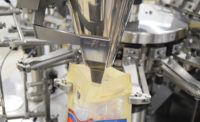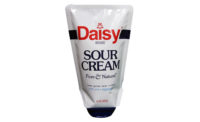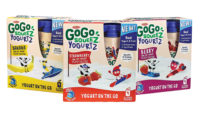Although bottles, cartons and tubs are widely used, flexible plastic packaging dominates in the global dairy industry. With a market share of more than 27%, it owns a larger share than rigid plastic, paper/paperboard, glass or metal packaging, according to Global Dairy Packaging Market 2016-2020, a report from London-based Technavio.
The growth is not surprising. According to the Flexible Packaging Transition Advantages Study, published in June 2017 by the Flexible Packaging Association, Annapolis, Md., 55% of brand owners reported a sales increase when asked about the impact of flexible packaging.
When given the choice between the same product in non-flexible packaging, 40% of consumers said they prefer flexible packaging for cheese/dairy products. They also are willing to spend more for food packaged in flexible packaging.
Dairy applications include lidstock for tubs and trays, overwrap, pouches/bags, stick packs and tubes. Many functional features can be incorporated, such as easy-open tear strips, easy-open/reclose zippers, peel/reseal flaps and dispensing fitments. Flexible packaging also offers sustainability advantages and addresses demand for single-serving products.
Individually packaged novelties
Source reduction and suitability for single servings sold The Fatboy Cookie Co. of Midland Park, N.J., on flexible packaging. Joel’s Outrageous ice cream sliders, made from Joel’s Outrageous cookie dough, are assembled, partially enrobed in chocolate and packaged individually at a co-packer.
Joel Ansh, president of The Fatboy Cookie Co., said he considered a carton but “our co-packer talked us out it. When we looked at the cost, the printed rollstock was much more cost-effective. That’s the advantage of using co-packers. They can tell you what works best.”
After considering a larger size sandwich, the slider size was chosen. It not only provides the optimum serving of the rich, grab-and-go treat, but also an appealing price point. All-natural ingredients in the buttery cookie recipe and 14% butterfat ice cream provide a clean label and make the slider “very satisfying,” Ansh said.
Newer ideas
A single-serving size is the latest addition to the Ecolean pitcher-shaped pouch lineup from Sweden’s Ecolean A.B., which has an office in Plano, Texas. The new on-the-go size of the Ecolean Air Aseptic pouch holds 125 milliliters (4.2 fluid ounces). The pouch design combines product differentiation with environmental and functional attributes.
An air-filled “handle” stabilizes the package and makes it easier to pour. The polypropylene (PP)/mineral-filled PP/ethylene vinyl alcohol/carbon black/polyethylene substrate includes barriers to oxygen and light and contains 40% calcium carbonate (chalk), which enhances strength and stiffness. The structure weighs substantially less than competing cartons or bottles, and its flexible nature allows complete evacuation, thereby reducing food waste.
The supplier offers pouches for chilled distribution and an aseptic line for ambient distribution. An integrated SnapQuick device simplifies reclosure. Volumes range from 125 to 1,500 milliliters (4.2 to 50.7 fluid ounces).
Yogurt in a pouch
Pouches with dispensing fitments are gaining ground for products like yogurt for a simple reason: no spoon is needed.
“That’s where flexible packaging is going to gain share,” predicted Bob Madderom, business development manager at Vonco Products, LLC, Lake Villa, Ill., a supplier of premade pouches.
A no-spill fitment prevents drinkable yogurt or flavored milk from creating a mess if the pouch is dropped or tipped over. The package integrates the Cheer Pack spouted pouch from GualapackGroup, Castellazzo Bormida, Italy, with the SimpliSqueeze valve from Aptar Food + Beverage, Crystal Lake, Ill.
The design combines convenience with peace of mind and easy squeeze-and-drink capabilities.
“We believe there will be a tremendous number of opportunities for the new no-spill pouch in the dairy beverage market,” said Alan Sica of Aptar Food + Beverage.



